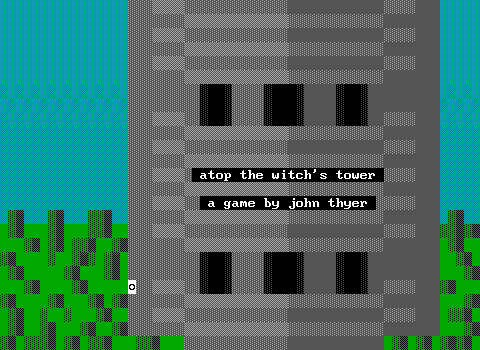Third Time's The Charm
This is the third and final entry in the Gem Hunter series and comes well over a year after the release of the second game. These games are named for their protagonist Gem Hunter, a Da Hoodian who travels the galaxy in search of rare gems.
At least, that's what he does on paper. In practice, Gem Hunter's adventures are never as simple as rock collecting. It's a far fairer assessment to say that what Gem Hunter really does, is kick people's asses. If you are evil, or dweeby enough, Gem Hunter has no problem "laying the smacketh-down", with author Tseng being unable to resist the opportunity to add in machismo and showiness of pro-wrestling whenever he can. The Gem Hunter series is a series about dudes being tough and intimidating one another constantly.
Unlike the previous games, which seem to have been created by Tseng because he wanted to do so, Gem Hunter 3 feels as if it was made to sate the demands of certain community members. The game comes off as a victim of the previous games' successes. The game's main menu includes a thesis statement for the game's creation: to silence the critics of November Eve who weren't happy with the game being 90% cut-scene. (An extremely valid complaint.) This time, Tseng promises to create the "perfect mesh" of graphics, programming, and gameplay. An ambitious goal that fails to consider Tseng's own fatigue with the Da Hoodian universe where the vast majority of his games were set.
The good news is that though dire at times, Gem Hunter 3 is still a pretty decent experience, and certainly does offer more gameplay than November Eve. Tseng has some interesting ideas here. The game maintains its predecessor's non-linearity, but rather than dump players in the middle of a large open world, it gets its structure by allowing players to pick from a set of six stages. Each stage gets to have its own distinct environment, hinted at by a single word description when choosing a stage. Some are obvious enough like "fire" and "ice" dimensions. Others are a little more abstract: "Stupidity". "Evil". One is even based on the popular ZZT IRC hangout of the day, #darkdigital.
But it is very much a troubled game. There's little focus to each stage, many of which have don't give players much to do beyond wandering from board to board until they uncover a key needed to access the dimension's boss room. Tseng's massive repertoire of characters is surprisingly absent, replaced instead with an equally surprising number of ZZTer cameos.
Many of the highlights of the previous game just aren't here. The titular gem hunting is now all or nothing, with the game's second file offering an extended ending for those that find them all. Once again the process of doing so is unpleasant, and use of a walkthrough is recommended. Despite being one of the final releases of such a prolific developer, the game feels a bit sloppy, hurried, and just lacks the excitement seen in the previous games.
What happened here? How bad does it get? And what is Tseng so focused on instead of what made the previous games beloved titles of the era? Brace yourself for a long journey through the defenses of Snilloc Lihp as we search more for answers rather than gems.

Snilloc Lihp
Gem Hunter has had a miserable time of getting off the planet Da Hood. Back in Gem Hunter 2 his traveling partner Kim was captured by members of the Evil Weasel corporation, forcing him to roam around the city of Puerto Del Agua beating up anybody associated with the group and rescuing her.
This was then followed by the events of the Parasite Eve parody/spin-off game November Eve in which Kim's human genetics kept her safe from the Da Hoodian equivalent of a mitrochondrian uprising, forcing Gem Hunter to mostly sit around waiting to be able to just leave already.
Well, he's finally gotten off that planet. Word gets out though that there's a bit of a shakeup going on with the villains. Masamune who was thought to have been killed in... pretty much every game Tseng released, is in fact alive. Again. He's kidnapped Absentminded's previously unknown sister Torie, an incredibly powerful psychic and intends to siphon her powers in order to power a device capable of blowing up Da Hood from his new secret base on the volcano planet of Snilloc Lihp. (Read it backwards if you haven't already.)
Getting to the planet is easy. Getting inside the base, not so much. The only entrance is protected by dimensional locks which can only be opened by traveling to alternate worlds via portals and defeating their respective guardians.
Like its predecessors, item collecting is a core component of the game. Gems are hidden all over the place, sometimes in plain sight, sometimes in sensible places to hide gems, and sometimes in awful locations that no player would find without investing way too much time in the game.
In the first game (and its remake) players could settle for a lesser ending if they didn't find every last gem, while those who pulled it off were treated to extra boss fights and an extended ending. For the sequel, Tseng incorporated the gem hunting more directly into the events of the game, requiring some, but not all to be able to proceed to the area where Kim was being held captive. Getting all the gems here again meant an extra fight and better ending.
For the third game, Tseng pivots a good amount from what's been established. There are still lots of gems to collect, yet you can play the game without picking up a single one. There's still extra content for those that enjoy the hunt, but the emphasis on gems just isn't there this time. Perhaps after seeing how sometimes cruel they could be hidden, I no longer felt like putting in the effort to finding out how to get certain gems that could result in Gem Hunter's death if approached wrong. Why bother when I was almost certain to miss a bunch regardless.
The gem collecting has always been a bit of a mixed bag. It encourages players to investigate everything they come across thoroughly. It feels rewarding to find some of the tougher ones. Yet all too often Tseng would go overboard in how well they were hidden. Players would sometimes need to touch dozens of identical wall tiles to find a gem with no hints offered as to which board this was the case on. Other times gems could become unavailable, such as a man in the second game that gives you a gem in exchange for not shooting him, only to have a second gem drop if you shoot him afterwards. Shoot him first, and the peace treaty gem can no longer be obtained.
All the usual complaints still apply. Players aren't told how many gems there are to collect until the end of the game's first file. The different dimensions also lack individual totals, so players that want to go back to find what they've missed will have no idea which areas need to be revisited and which are a complete waste of time. That much of this game's development was focused around righting the wrongs of November Eve, I'm really surprised that the gem collecting has not been refined at all over the entire series.
The Six Dimensions
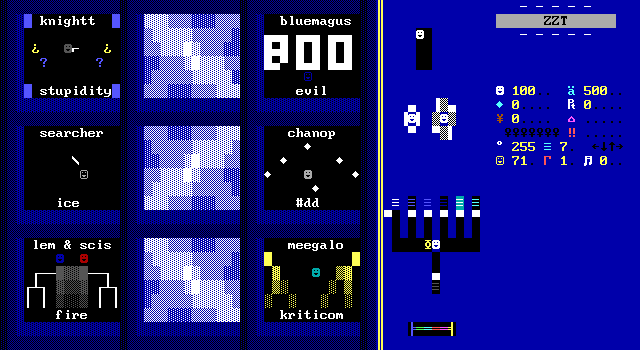
Another major departure for the series in in the main structure. The first game was a mostly linear tour of an island. The second, a non-linear exploratory adventure through various districts of a city. For the third, Tseng keeps things non-linear, but breaks the game up into six regions that have no connection to one another whatsoever.
Everybody benefits from this. Tseng gains the freedom to create whatever kind of dimension he likes, free of the urban environments or sensible geography he was locked into previously. Players get the obvious perk of variety, with the more subtle advantage of avoiding lengthy walks to get from point A to B.
Now the game simplifies travel, using a Mega Man inspired stage selection screen that provides a list of dimensions and the guardian that must be fought at the end.
Player clones are used to capture the keyboard input for moving the cursor. Pressing space will lock in a selection allowing the actual player to walk to the appropriate passage. It's basically a more complex version of the world map used in November Eve.
One caveat with the engine here is that if the player shoots at a wall, the engine increases their ammo by one allowing you to obtain infinite ammo. While Tseng doesn't explain this method of getting more ammo, he does mention that there is a way to get infinite ammo on this screen, and that he decided to leave the bug in intentionally.
A weird decision, but free ammo is free ammo. The trouble is that this isn't a very good way to increase your ammo, and perhaps because of this bug-turned-feature, Tseng almost never gives the player more ammo in any level. Players receive 500 to start off, a great starting point, but not enough to make it through the entire adventure unless you were to play very cautiously. The need to actually make use of this exploit, sanctioned or otherwise, is a major sticking point with the game.
We're in clear Mega Man territory here too. This screen is the perfect opportunity to reset the player's ammo and health to a fixed value before they enter the next stage. If you do run out of ammo in a stage, even if it's the killing blow on the boss, not having any ammo on this screen would mean being unable to lock the cursor, making certain stages inaccessible, probably causing the game to become unwinnable entirely. It's an extreme hypothetical, sure, but the previous games were better about resource management, as well as offering shops to buy extra supplies, something the third game cuts out entirely.
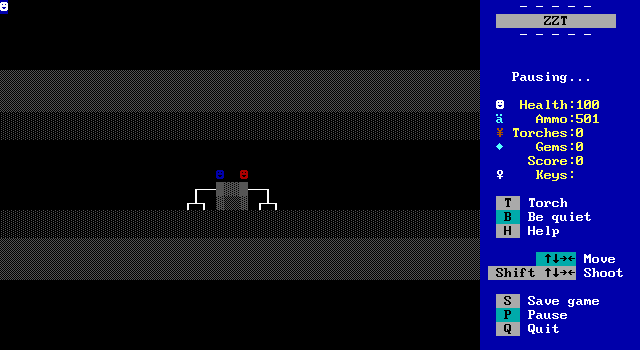
Picking a stage treats players to a Mega Man style introduction to the boss of the dimension. These animations are very lovingly made with some impressive visual effects, along with being set to the game's most tolerable music (which is good because you'll hear it a lot). The bosses themselves moving around in these scenes really provide a sense of polish that can be hard to find in much of the game. The effort spent synchronizing all these multi-object animations truly feel like something most other authors wouldn't have bothered with.
Though it gets weird at the end, with the background turning an ugly looking dark cyan and making the player wander around in their tiny corner to find the invisible passage to actually start the level.
The Carnival of Slaves and Fire (Lemmer/Scissorman)
For my first choice, I wanted to take advantage of having my pick of levels, and jumped to one in the middle. The fancier names for the dimensions aren't stated in game, only mentioned in the anthology edition's documentation which includes the ever-helpful gem list.
Gem Hunter isn't alone in this game, though he certainly doesn't get any help. Both his now canonical girlfriend Kim and his old buddy Tyrone accompany him to each dimension. They're usually found close to the starting board of each stage, offering some conversation fodder. They rarely have anything relevant to say, and never show up to help deal with enemies or the guardians themselves despite both being well known for their heroics as protagonists in other Tseng games. For them, Gem Hunter has volunteered to break the locks, while they just get to be tourists.
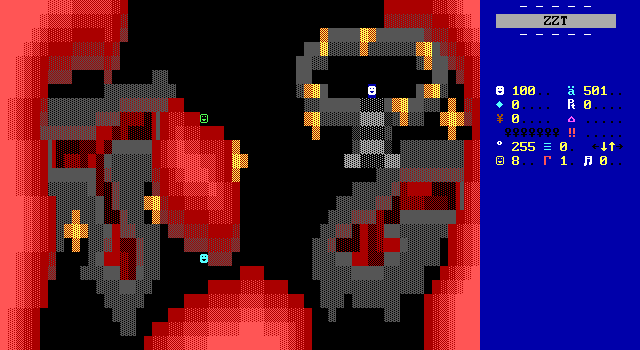
While each stage is now cleanly isolated from the rest, the element of open exploration is still retained with starting screens such as this one giving players some small choice in where to head first. These individual levels aren't all that big, so many alternate paths immediately reach their conclusion, making levels feel rather quick to explore fully. Any board that isn't on the critical path can be assumed to be included to either hide a gem or feature a ZZTer cameo.
Each level is populated with some form of NPCs. For this first stage, you've got your demons, and you've got your slaves to the demons. It's not exactly Hell, though the association comes easily enough. It's unclear what they're doing exactly, though it doesn't matter. This is a Gem Hunter game, and if you are a character that doesn't have a name, you do not matter. No comments are made on the use of slavery or torture seen on this planet.
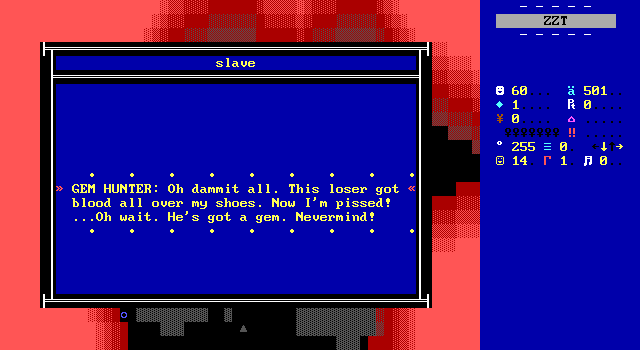
This is the extent to which the gang cares about anything really.
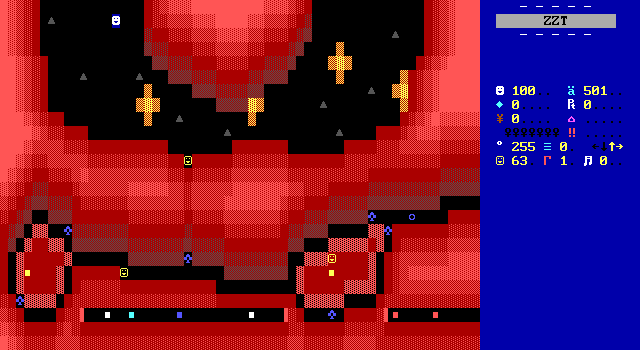
Of course, even if you're not interested in the NPCs, that doesn't mean you can't interact with them entirely. A slave right by the starting board gestures at the left wall as a hint of where a gem can be found. It's a terrible hint though, since the gem is actually on the right wall! It's only on the left if you're considering Gem Hunter to be facing south, and interpreting the "left" as relative to Gem Hunter's perspective and not your own view of the board in its entirety. After touching a bunch of nearby walls and finding nothing, I just moved on.
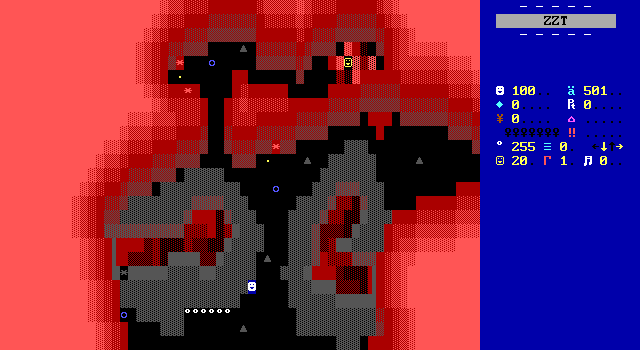
The other path from the start gives us our first demonstration of what the gameplay is like. Hardly every board is peaceful after all. This planet's primary obstacle are these blue rings that shoot a stream of bullets when the player lines up with them. They do a good job of giving players a reason to watch their step, and offer something to react to if they don't. A few ricochets are placed near them that allow Gem Hunter to make some bank shots and destroy them properly. Otherwise their bullets will overwhelm your ammo supply eventually.
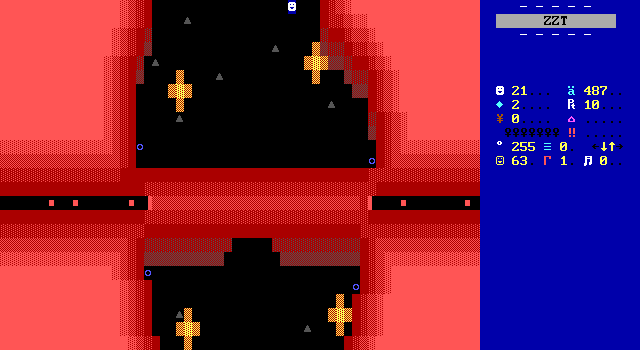
Tseng does start off strong graphically. His bizarre shading from November Eve has thankfully been abandoned, and while the current shading is pretty basic, there's some nice decoration to be found in this level in the form of this assembly line that runs the course of the whole planet with hidden conveyors sliding boulders along and tunnels for them to travel through.
This same board also makes use of the technique of using invisible transporters to allow players to pass underneath bridges like this. In worlds of a lower quality, this technique's employment may not be clear to players, leaving them scratching their heads trying to figure out how to reach the other side. Here the limited boards players can reach, the opening in the bottom of the bridge, and the fact that more of those blue ring enemies await all effectively communicate that the wall isn't as impassable as it may seem.
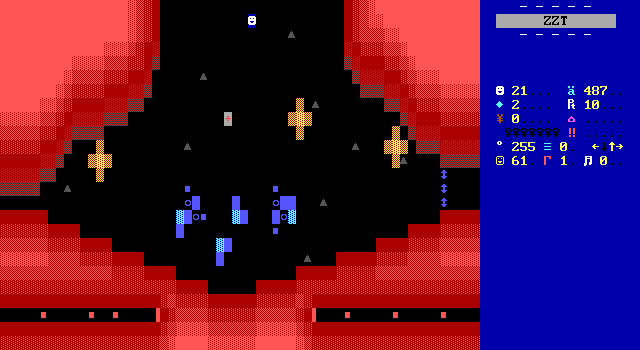
The blue rings are also finagled into playing the part of a puzzle component. Players get a standard Sokoban style puzzle with boulders to push on to fakes. The blue rings, without any ricochets to destroy them, add a twist to this open-air puzzle, asking the player to come up with a way to move the boulders without taking too much damage.
It's a good idea, though it leaves a bit to be desired as the rings fire so fast that you'll always take some damage. A bit of restructuring the layout so that players could make a break for it safely would have gone a long way. Tseng, to his credit, acknowledges the issue here, providing a med-kit to make up for the inevitable health loss. Rather than restoring a few health, grabbing it provides 300! Presumably Tseng didn't feel like sprinkling these things anywhere there were blue rings.
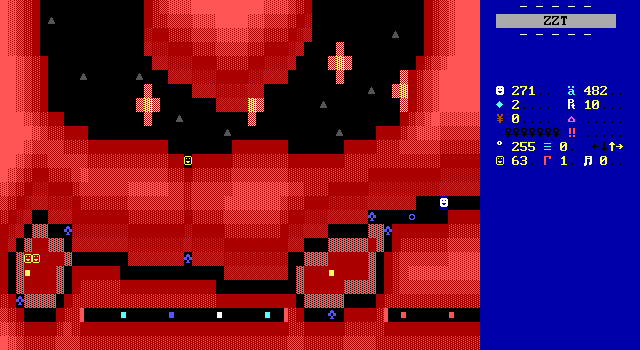
As clear as it may be that Tseng's intentions are good, this level has one baffling decision. Players can manage to bring Gem Hunter to this earlier part of the level from another side, where they'll seemingly get their first chance to actually interact with any of the demons. One last blue ring is in the way, with no ricochet around to be able to destroy it. Even the breakable wall that borders it is actually an object in disguise. There's no way to actually reach the demons, and as such they have no code.
So what I want to know is why bother letting the player reach this area in the first place?
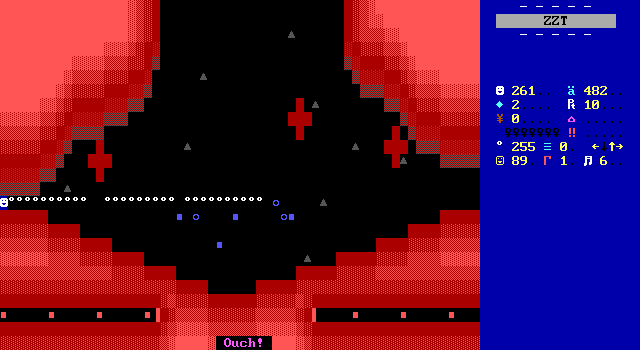
I especially wanted an answer to this when I realized that trying to the leave the pointless half of the board would mean walking directly into a barrage of bullets from a ring.
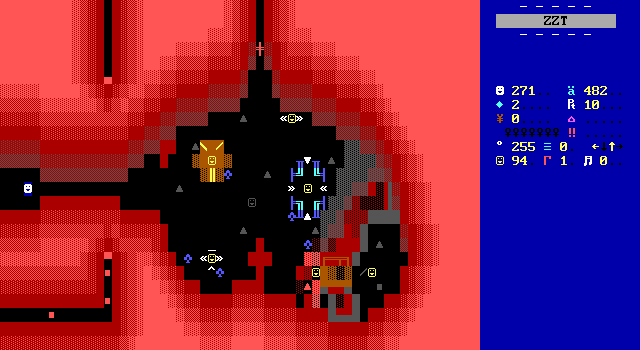
While Tseng won't let Gem Hunter interfere, question, or even acknowledge the slave situation here, he does permit him to waltz into a torture chamber. Talking to any of the demons gets a "Hit it." message followed by a gory little animation of a slave being killed for the fun of it. Morbid stuff!
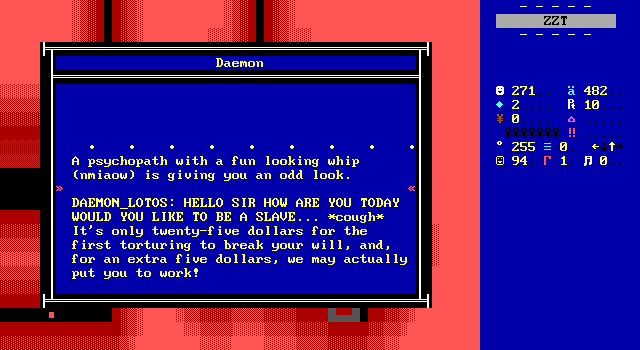
The only character of note is a cameo of ZZTer Daemon Lotos who offers Gem Hunter the chance to be a slave for a bit. Most of this game's bosses are not Tseng characters, but ZZTer cameos. There's documentation that mentions the game originally having been intended to have eight stages instead of six, which makes me wonder if Lemmer and Scissorman were always intended to be the boss here or if that boss was coded before the plans for eight stages fell through. Given all the demonic influence, Daemon would be a much more fitting choice for this than the much more aloof duo fought instead.
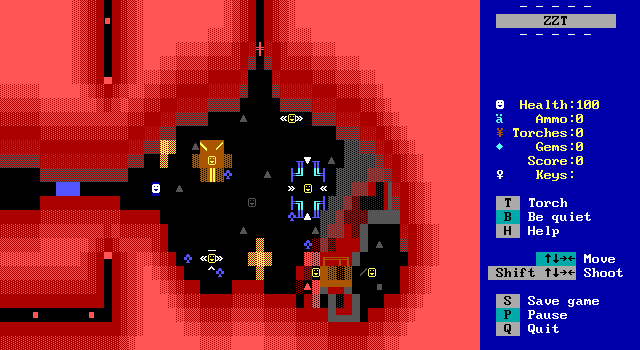
One lucky fellow instead gets to smash a hammer into a rock for eternity, which gets an equal amount of attention to the animation as any of the grislier moments.
The whole scene is a gratuitous example of ZZT violence, which is to say, smiley faces getting turning into red fakes. The complete detachment Gem Hunter has to this is what makes it a lot more off-putting than likely intended. This is the sort of material you expect from an AOL-era Barney killing game, not a game from the 2000s that's a new entry in a popular series.
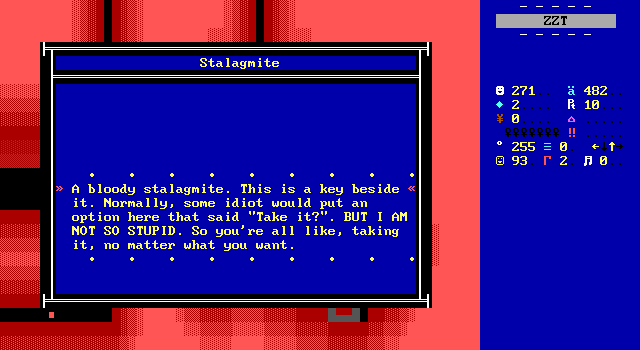
Investigating everything is a staple of Gem Hunter in hopes of finding those previous gems. Since players can be assumed to be putting in at least some effort towards finding them, Tseng has the opportunity to hide other items in suspicious places without having to worry about players being oblivious. Anybody with even the most basic familiarity with the series is going to keep their eyes peeled, so if one spike is bloody, that's going to stick out clearly.
Tseng also takes the opportunity to comment on the meaningless choice players are frequently given to turn down an item that's obviously mandatory to proceed. Despite this, at other times in the game there will indeed be Yes/No prompts for key items played completely straight.
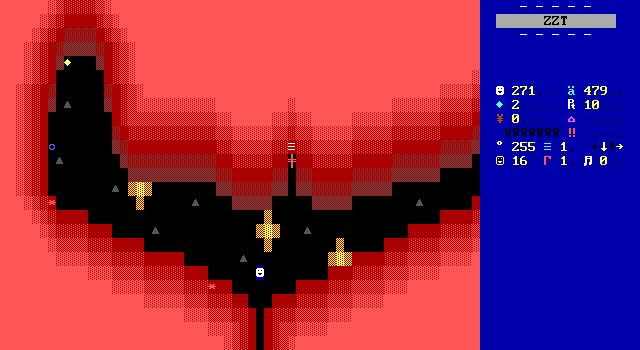
Tseng can also play with gem collecting knowing that players will rush towards anything that looks like a gem in plain sight. This one turns out to be a fake gem with a key inside, so despite Gem Hunter's disappointment, it's well worth the player's time. Having one key be hidden in a stalagmite followed by another in a gem forces players to engage both in the item hunting component as well as ensuring that anybody who would dare to not care about the gems at all still needs to make a habit of grabbing them.
The first rule of Gem Hunter is that you have to hunt gems. You don't have to actually find any, but you do have to hunt them.
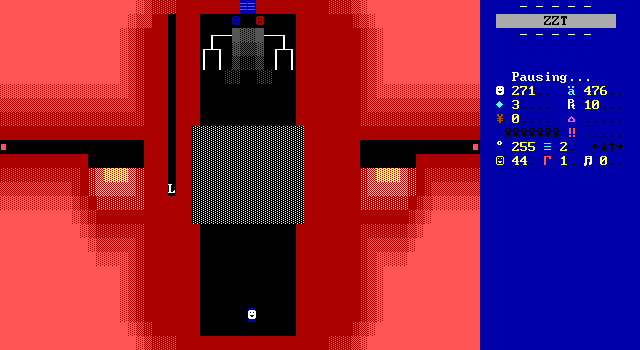
Our guardians and first bosses are Lemmer and Scissorman. This is an instance of cameos in this game getting to recycle their roles from November Eve. Just as in that game, the two set perched atop a giant mechanical body with spiky arms to stab and shoot with.
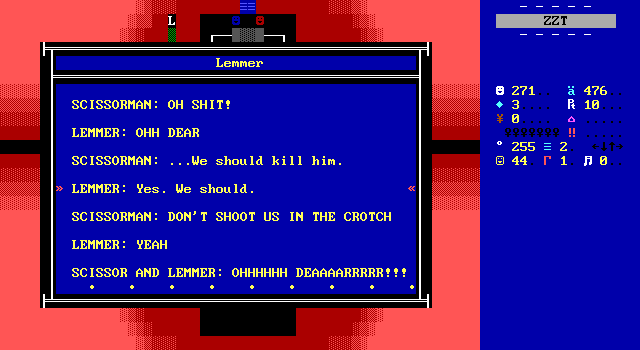
For as much of the game's humor doesn't land today, but the sudden announcement of DON'T SHOOT US IN THE CROTCH had me laughing.
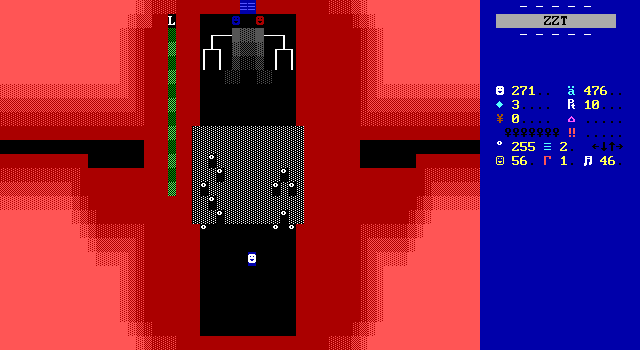
It plays very similarly to Kim's fight from November Eve, but now with the player doing the maneuvering rather than steering around an object for a Parasite Eve style combat engine.
A body of water keeps the player from getting anywhere near the two, while they perform one of several attacks. Their arms can shoot bullets down the sides, and some spikes can appear that move from the center of the board outward while they shoot...
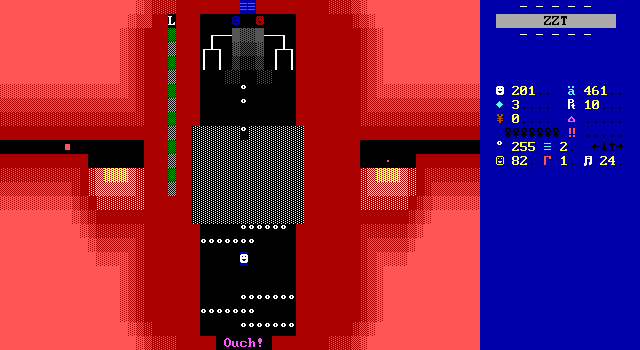
...Or a very mean attack that makes the playfield flood with bullets can be used. Each row's bullets come from alternating sides so you can dodge by shooting in the correct direction when the attack begins. Good luck though, as the attack isn't telegraphed so you have to rely on reflexes when the bullets start firing. Expect to lose a lot of health.
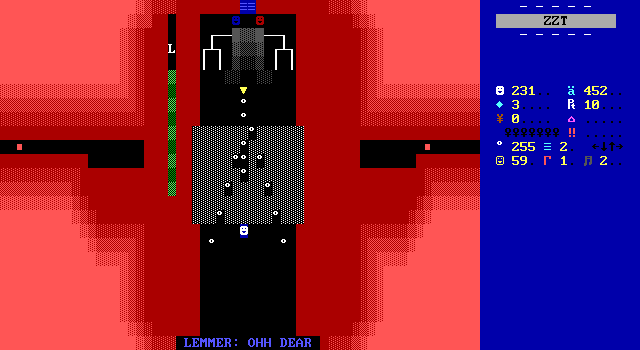
It might be easier to just hug the wall opposite of where a row's bullets are fired from, but there's a catch. Lemmer and Scissorman can only be harmed if you shoot them in the crotch as the specifically requested you not do. Though appearing unguarded, the yellow spikes sit invisible in the middle when not attacking, blocking access to the all important crotch. This means waiting for an opening and standing in the center at all times as the window to getting a shot in is rather narrow thanks to the long distance bullets need to travel upward.
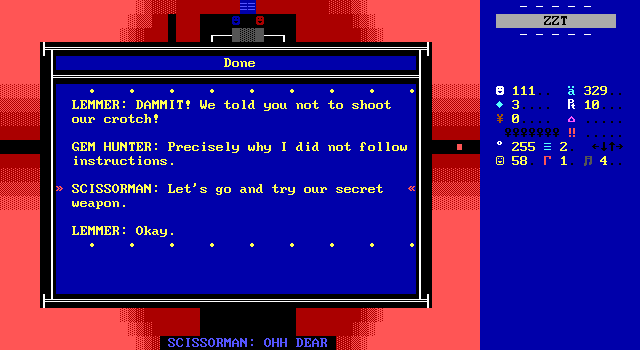
The fight isn't entirely copied from Kim's previous adventure. In GH3, after their health has been drained, Lemmer and Scissorman hop down from their seats and engage in direct combat. There will be so many bullets flying around once the fight enters this phase, that one will almost certainly kill the other quickly, letting Gem Hunter finish off the survivor with little effort.
Once the guardians have been defeated, the walls lower allowing the player to enter a passage that returns them to the stage select. No quips or comments from Gem Hunter after the victory, or even an acknowledgment that one of the dimensional locks has been broken.
This Mega Man inspired structure can also be found in the ZZT world Overflow, which was at least kind enough to mark your success with a keycard for defeating a boss as some physical token representing the victory. Tseng really just wants you to move on to the your next dimension, making the player's victory seem really down-played.
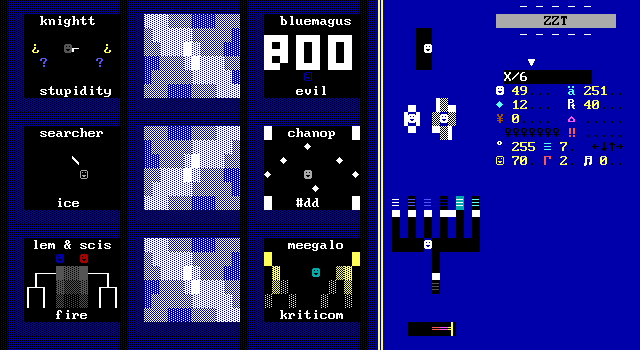
Annoyingly, there's no easy way to tell when you've completed a world. Each time you do, a little piece of rainbow line wall disappears at the bottom to mark how many stages you've finished, but not which. This likely comes from the fact that you need to be able to return to previous stages to search for any missing gems. Some indication that the boss was defeated would have been appreciated though. Perhaps replace the smiley faces that represent each of the bosses with a red fake after they're been killed?
There's also zero feedback for how many gems were collected in a level. If you aren't consulting the anthology's gem lists, you'll have no way to tell if you've actually found everything in a given stage.
The Beaches of Stupidity (Knightt)
For my second stage, I opted to go with the first on the list. Going by the order the boards are listed within the world, things were made starting with the left column going down and then the right making this the closest thing to a "first" stage.
I had a few questions on my mind as I entered the passage. Would there be a noticeable difference in difficulty? Would the quality be higher with Tseng starting fresh? Or would it be lower as Tseng had yet to get himself into a groove of what the dimensions of Gem Hunter 3 were all about?
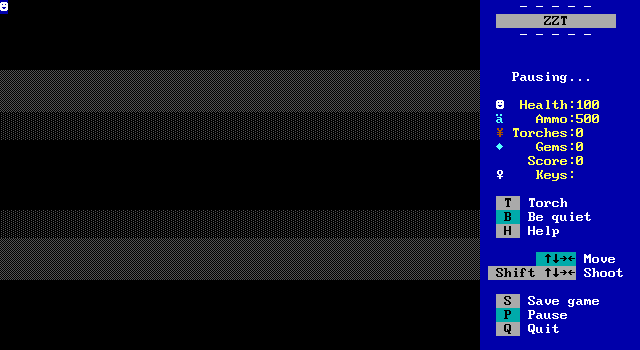
The first thing I got was this amazing animation of Knightt flailing wildly with a gun. Lemmer and Scissorman had the luxury of their November Eve machinery while the other ZZTers that take on boss roles are just handed whatever random weaponry Tseng assigns them. If we're supposed to be leaning into names here with Daemon Lotos being a demon, I would expect Knightt to have something perhaps a bit more medieval.
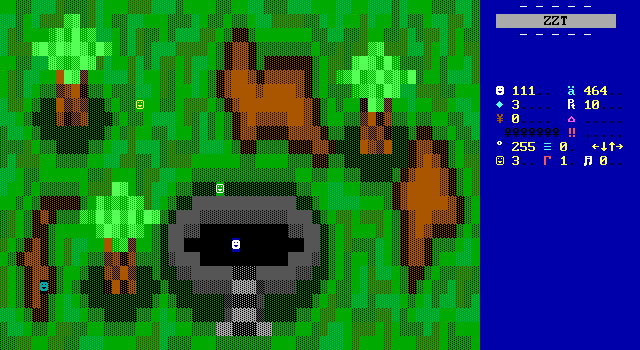
Immediately I felt this was expected to be the player's first choice. There's no hostile environment here, just a standard ZZT field. It's much more serene feeling, reusing the aesthetic of the island from the first game.
Kim and Tyrone are nowhere to be seen, though they aren't far from here. Instead an assortment of new NPCs welcome the player, introducing them to this new world of stupidity.
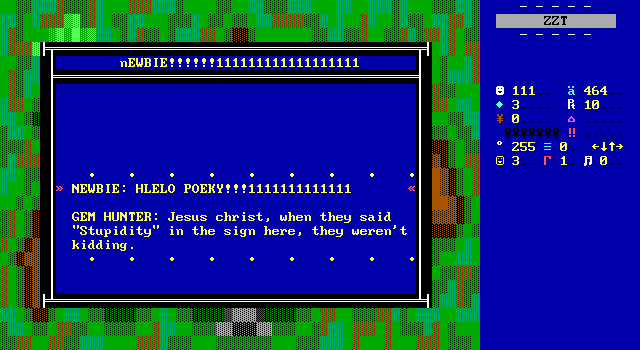
The webcomic Pokey the Penguin was a longstanding hit with the ZZT community, and the unusual way characters spoke in it was a popular way to depict clueless ZZTers. HOORAY!
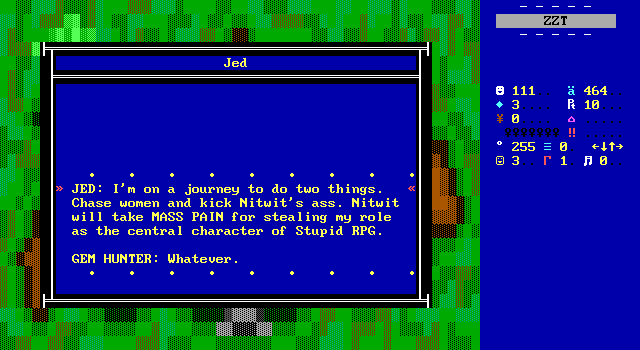
The Pokey references give way to a new kind of cameo, the inclusion of characters from other games. Jed of Stupid RPG fame is here and his inclusion means absolutely nothing to me, so I can relate to Gem Hunter's cold response.

Despite this dimension and Lemmer/Scissorman's having the same number of boards, Knightt's stage feels much faster to get through. It doesn't take long to figure out why. From the entry point, players are one board away from the castle where Knightt resides, where a jammed door is his only line of defense until Gem Hunter can find something to pry it open.
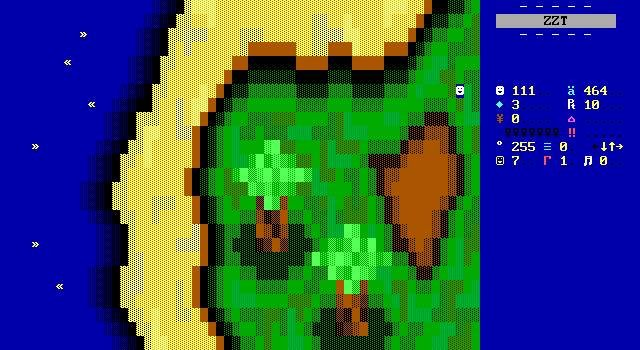
But the rest of the island is very sparsely populated with anything really. There are some fish that swim back and forth along the coastline, a few more cameos from Tseng and Knightt games that don't amount to much, and some pirates that just say "ARR".

Off the coastline on one board a small pirate ship offers something of interest to examine. The pirates are men of few words, not even reacting when you kill the one guarding the ammo and gems they have in storage. The ship ends up being notable just because it's the only additional source of ammo in the game that doesn't come from exploiting the stage select engine.
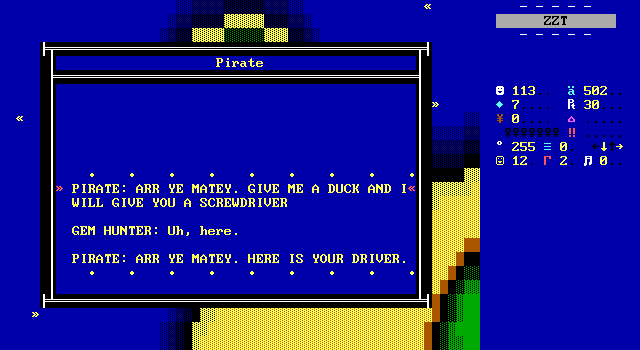
The solution to the stuck door is a screwdriver, which a pirate will trade for a duck. The duck meanwhile can be found by talking to a random guy who says Knightt owes him money and tells you to use the duck to kill him.
Gem Hunter is more of a gun guy when it comes to his murders, so the trade is made and the door pried open.
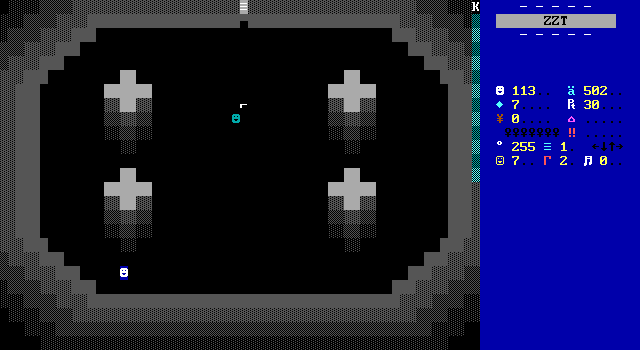
There isn't even a little interior to explore. The moment players get inside the castle, it's time to fight Knightt.
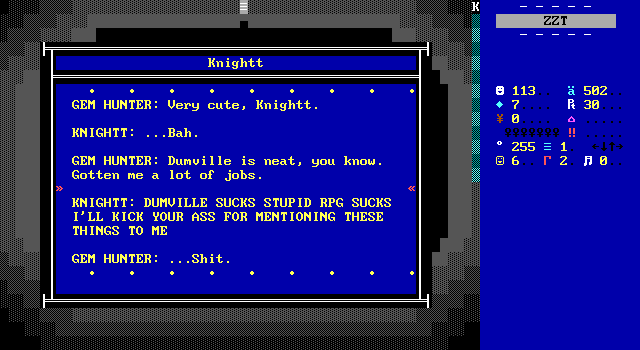
Knightt's dialog gives us a bit of an insight into the ZZT community at this moment in time. Despite making dozens of the things, Knightt's opinion of his own work was frequently negative. It's kind of rough to be immortalized like this.
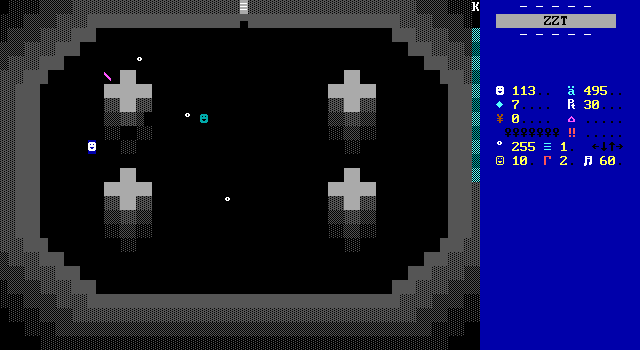
As for the fight itself, Knightt is a very standard boss battle. He moves, shoots, and throws a star when hit. The four pillars in the arena function as helpful obstructions that players can run around to keep any stars out of their hair for a little while, as long as Knightt cooperates and keeps himself positioned near the center of the room.
The use of breakable walls in the pillar shading can also be used to destroy a star that connects with it instantly, giving players the ability to speed things up a little.
For most ZZT games, what's here is an enthusiastic "pretty good". Given Tseng's history and Gem Hunter 2 having some of the most innovative boss designs I've seen in ZZT, it's a bit underwhelming even if there's nothing actually wrong with the fight itself.
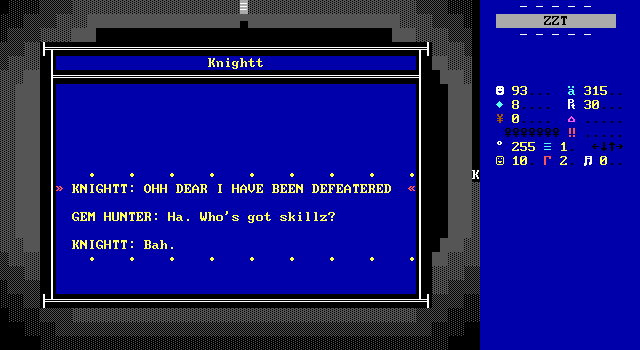
This time at least, there's some minimal acknowledgment of the player's victory. Thinking about it now, the lack of any text previously may have been due to Lemmer and Scissorman being able to be defeated in either order, though even so there had to be an object to open up the exit that could have had some dialog slipped in.
The door opens and the player can return to select their next stage.

